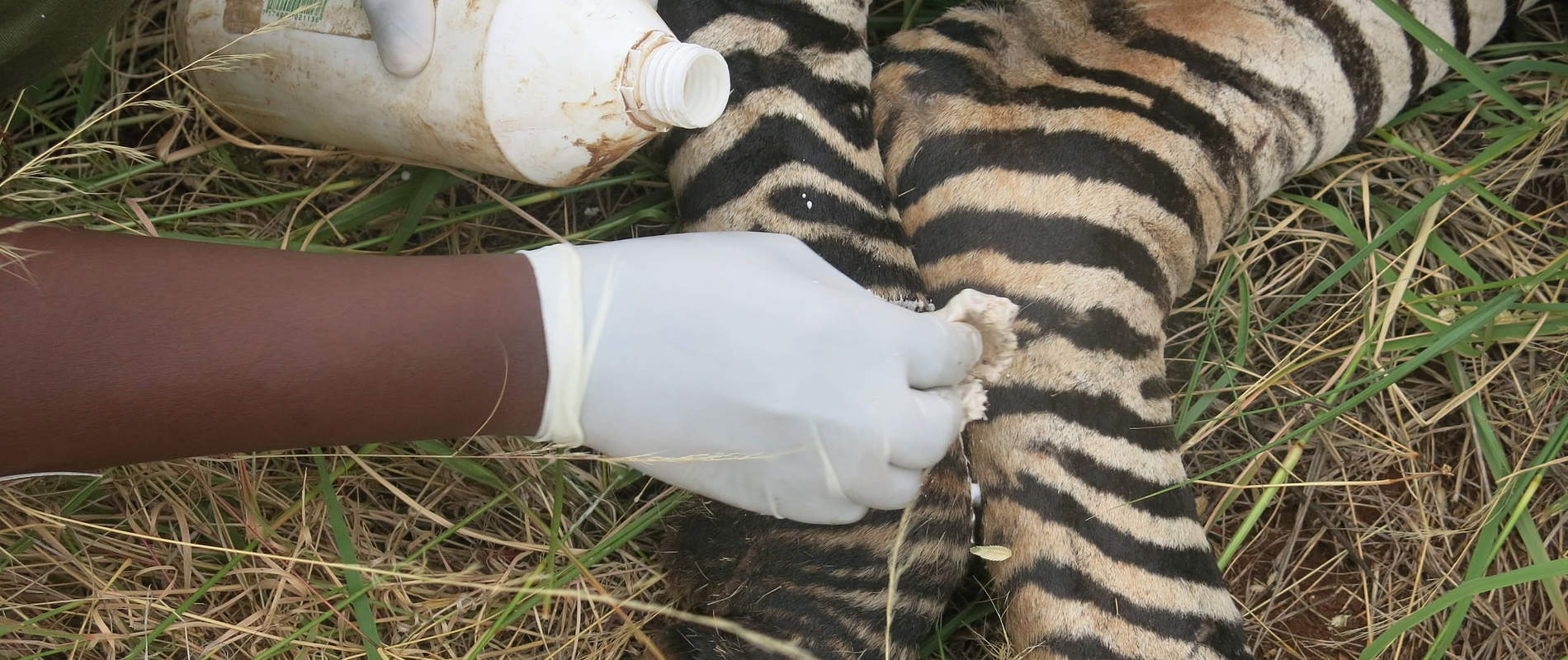EASTERN CONSERVATION AREA VETERINARY UNIT MONTHLY REPORT JULY 2016 Report by: Bernard Rono Summary This report describes the activities of the Meru Veterinary unit in July 2016
EASTERN CONSERVATION AREA VETERINARY UNIT MONTHLY REPORT JULY 2016
Report by: Bernard Rono
Summary
This report describes the activities of the Meru Veterinary unit in July 2016. Northern Kenya experienced dry weather during this month, however, pasture and water resources were available following the long rains season.
In Loisaba Conservancy an elephant was treated for lameness caused by suspected gunshot injuries. We also immobilized a common zebra in Meru National Park to remove a snare and treat resulting wounds on the leg. An elephant which showed lameness in Kirisia Forest Reserve could not be traced for treatment.
We would like to acknowledge the financial and logistical support provided by the David Sheldrick Wildlife Trust to enable treatment of injured wildlife in northern Kenya.
CASE #1: REMOVAL OF A SNARE IN A COMMON ZEBRA
Date: 06/07/2016
Species: Common Zebra
Sex: Male
Age: Adult
Location: Meru national park
History
Rangers on patrol reported that a common zebra had injuries caused by a snare in Mulika plains, Meru national park. After a two day search we found the zebra which suffered lameness. It was immobilized to remove the snare.
Immobilization, examination and treatment
A combination of Etorphine and Medetomidine Hcl delivered in a 3 cc Dan-Inject dart was used to immobilize this zebra. Darting was done from a vehicle and the dart was delivered into the left thigh. The zebra went down in 3 minutes.


Examination showed a swollen left limb distal to the hock joint. The snare seemed to have fallen off during darting but there were deep lacerations caused by the snare.


The wounds were washed using an antiseptic and debrided using Hydrogen peroxide. Povidone iodine was also applied. Antibiotic and anti-inflammatory drugs were administered by intramuscular route.


Reversal
After treatment Diprenophine Hcl and antisedan were given through the jugular vein for reversal of sedative drugs.
Prognosis
Five minutes later this zebra was fully reversed. It is expected to make a complete recovery soon.
CASE #2: EYE INFECTION IN A BUFFALO
Date: 09/07/2016
Species: Buffalo
Sex: Male
Age: Adult
Location: Leopard Rock, Meru national park
History
A buffalo in Leopard Rock lodge was reported to have shown blindness for two weeks and required veterinary evaluation on its welfare. It was usually seen around the lodge at night may be due to its security.
The buffalo which was examined on 9th July was found to be in good body condition. It showed a swollen left eye and slight purulent discharge. The swelling on the left eye was reported to have reduced. The right eye was normal.

Traumatic eye injury was believed to be the cause of unilateral blindness. We recommended further observation of this buffalo.
CASE #3: TREATMENT FOR LAMENESS IN AN ELEPHANT
Date: 10/07/2016
Species: Elephant
Sex: Male
Age: Adult
Location: Loisaba conservancy
History
Scouts from Samburu Trust reported an elephant which showed lameness and a swollen leg in Loisaba Conservancy. The elephant had moved from Ol Maiso Conservancy where it had been reported four weeks prior but could not be tracked for treatment.
DSWT provided a helicopter for immediate response and darting.


Immobilization, examination and treatment
This elephant was immobilized using Etorphine in a dan-inject dart from a helicopter. Down time was eight minutes with the elephant positioned on right lateral recumbence.
Examination showed an infected puncture wound at the distal end of the left forelimb. Cause of the wound was suspected to be gunshot injuries which showed signs of healing. Manipulation of the leg did not show fractures.


The wounds were washed with water and an antiseptic before the necrotic tissue was debrided with Hydrogen peroxide. Povidone iodine was also applied. A systemic antibiotic Betamox trihydrate and anti-inflammatory drug Flinixin meglumine were administered.
Reversal
For reversal of anesthetic effect Diprenophine hydrochloride 42mg was given intravenously and the elephant came around after 4 minutes.


Prognosis
This elephant is expected to make a complete recovery soon.
CASE #4: INJURED ELEPHANT
Date: 19/07/2016
Species: Elephant
Sex: Male
Age: Adult
Location: Seiya lugga, Kirisia
History
Wildlife scouts in Kirisia forest reported that an elephant had shown lameness for four days. It was confined to an area at the edge of Seiya lugga with limited movement. An assessment was carried out with the aim of administering treatment.
On 18th July we found this elephant in company of another male in a thicket which was not accessible by vehicle. It was in good body condition. The elephant showed lameness of the left hind leg but we were unable to observe closely to determine the cause or extent of injury. This area was not suitable for darting.
On 19th July we were not able to trace the elephant for treatment. It had moved deeper into the forest. Area scouts will search and report when this animal is found.













